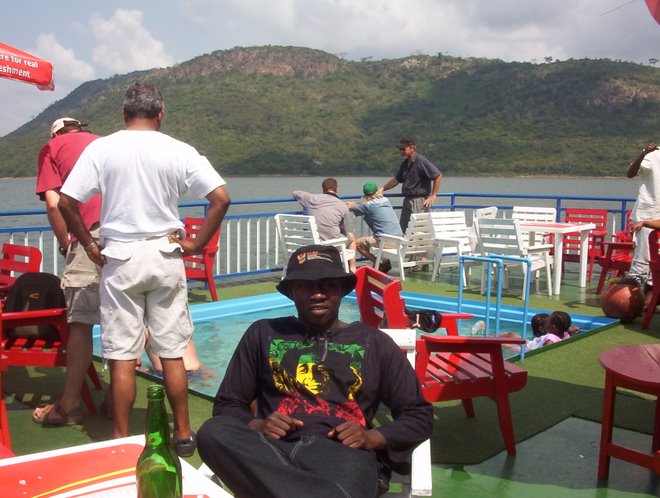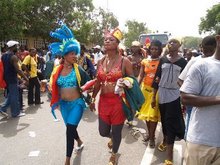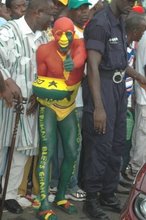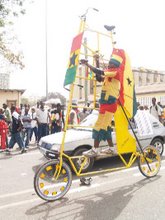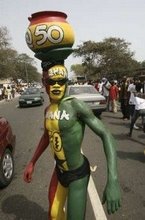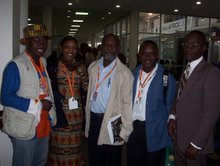Accra zoo animals arrive in Kumasi zoo
All animals in the Accra Zoological Gardens have been transported to the Kumasi Zoo to make way for the construction of the new Presidential Complex at the Flagstaff House.
In the meantime, arrangements are underway for the construction of a new modern zoo at a place identified in the Achimota Forest in Accra.
According to Professor Dominic Fobih, Minister of Lands, Forestry and Mines, the transfer of the animals would in no way stall the plan for Accra to have a fitting zoo.
The new Accra Zoo is to be built within the next five years with the help of the London Zoological Society. The animals are expected to be transported back to Accra upon completion of the new zoo in Accra.
The transfer of the animals has, however, enriched the Kumasi Zoo in terms of animal stock, putting it in a position where it can appropriately offer recreational grounds for relaxation.
This is because it now boasts about 60 different animal species on display including lions, elephants, primates, reptiles and birds.
Hitherto, it had only about 37 different species of animals on display and had become a pale shadow losing its status as a major tourist attraction in the Garden City.
Garden City.
The Kumasi Metropolitan Assembly (KMA) has pledged to help improve facilities at the zoo, which includes walkways and access roads.
At a ceremony to officially welcome the animals to their new “home” in Kumasi, Prof. Fobih stressed the need for the public to patronise the zoo.
The minister says it is unfortunate that many Ghanaians do not seem to appreciate zoos as facilities among the very important assets of the country.
“Most people therefore do not consider visiting the zoo when planning their holidays or leisure times”, he noted.
Zoos are in most cases the only opportunity for urban dwellers to have first-hand experiences with wildlife.
Prof. Fobih notes further that despite the numerous benefits of zoos there is a wide gap between revenues accruing in the form of gate proceeds and the cost of maintaining the zoos, thus making it difficult to run and maintain them.
 He said that despite such difficulties there was still the need to continue keeping the zoos for sustainable use of wildlife resources, conserving endangered animal species and researching for improvement in the management of various species of fauna across the globe.
He said that despite such difficulties there was still the need to continue keeping the zoos for sustainable use of wildlife resources, conserving endangered animal species and researching for improvement in the management of various species of fauna across the globe.
He expressed appreciation to all stakeholders for ensuring the safe transportation of the animals to Kumasi and also extended a personal appreciation to President Kufuor and the Asantehene, Otumfuo Osei Tutu II, for their immense interest and support for the zoo so far.
He appealed to other stakeholders including traditional authorities and corporate bodies to support the Kumasi Zoo so that it could deliver its expected benefits.
The Kumasi Zoo was established in 1957 by Dr A.A.Y. Kyeremanteng who also founded the Kumasi Cultural Centre.
 The Cultural Centre was set up to create a venue for the reinforcement of Akan culture among the youth. Another popular activity at the centre was the telling of Ananse stories.
The Cultural Centre was set up to create a venue for the reinforcement of Akan culture among the youth. Another popular activity at the centre was the telling of Ananse stories.
Thus the zoo was a natural extension of the activities of the centre because young people could go to the zoo to see the very animals they were hearing about in the Ananse stories.
The Accra Zoo was set up by the first President of Ghana, Dr Kwame Nkrumah, as a private menagerie in the early 1960s. The Accra Zoo was opened to the public after his overthrow in 1966.
In the meantime, arrangements are underway for the construction of a new modern zoo at a place identified in the Achimota Forest in Accra.
According to Professor Dominic Fobih, Minister of Lands, Forestry and Mines, the transfer of the animals would in no way stall the plan for Accra to have a fitting zoo.
The new Accra Zoo is to be built within the next five years with the help of the London Zoological Society. The animals are expected to be transported back to Accra upon completion of the new zoo in Accra.
The transfer of the animals has, however, enriched the Kumasi Zoo in terms of animal stock, putting it in a position where it can appropriately offer recreational grounds for relaxation.
This is because it now boasts about 60 different animal species on display including lions, elephants, primates, reptiles and birds.
Hitherto, it had only about 37 different species of animals on display and had become a pale shadow losing its status as a major tourist attraction in the
 Garden City.
Garden City.The Kumasi Metropolitan Assembly (KMA) has pledged to help improve facilities at the zoo, which includes walkways and access roads.
At a ceremony to officially welcome the animals to their new “home” in Kumasi, Prof. Fobih stressed the need for the public to patronise the zoo.
The minister says it is unfortunate that many Ghanaians do not seem to appreciate zoos as facilities among the very important assets of the country.
“Most people therefore do not consider visiting the zoo when planning their holidays or leisure times”, he noted.
Zoos are in most cases the only opportunity for urban dwellers to have first-hand experiences with wildlife.
Prof. Fobih notes further that despite the numerous benefits of zoos there is a wide gap between revenues accruing in the form of gate proceeds and the cost of maintaining the zoos, thus making it difficult to run and maintain them.
 He said that despite such difficulties there was still the need to continue keeping the zoos for sustainable use of wildlife resources, conserving endangered animal species and researching for improvement in the management of various species of fauna across the globe.
He said that despite such difficulties there was still the need to continue keeping the zoos for sustainable use of wildlife resources, conserving endangered animal species and researching for improvement in the management of various species of fauna across the globe.He expressed appreciation to all stakeholders for ensuring the safe transportation of the animals to Kumasi and also extended a personal appreciation to President Kufuor and the Asantehene, Otumfuo Osei Tutu II, for their immense interest and support for the zoo so far.
He appealed to other stakeholders including traditional authorities and corporate bodies to support the Kumasi Zoo so that it could deliver its expected benefits.
The Kumasi Zoo was established in 1957 by Dr A.A.Y. Kyeremanteng who also founded the Kumasi Cultural Centre.
 The Cultural Centre was set up to create a venue for the reinforcement of Akan culture among the youth. Another popular activity at the centre was the telling of Ananse stories.
The Cultural Centre was set up to create a venue for the reinforcement of Akan culture among the youth. Another popular activity at the centre was the telling of Ananse stories.Thus the zoo was a natural extension of the activities of the centre because young people could go to the zoo to see the very animals they were hearing about in the Ananse stories.
The Accra Zoo was set up by the first President of Ghana, Dr Kwame Nkrumah, as a private menagerie in the early 1960s. The Accra Zoo was opened to the public after his overthrow in 1966.




.jpg) According to the Acting Minister of Transportation, Hon. Felix Owusu Agyepong, the reconstruction of the KATH- Abuakwa road would involve five main components, mainly- the widening of the road from KATH to Abuakwa, the construction of an interchange at KATH and Sofoline, as well as the construction of five underpass bridges along the road and the landscaping of the entire road network.
According to the Acting Minister of Transportation, Hon. Felix Owusu Agyepong, the reconstruction of the KATH- Abuakwa road would involve five main components, mainly- the widening of the road from KATH to Abuakwa, the construction of an interchange at KATH and Sofoline, as well as the construction of five underpass bridges along the road and the landscaping of the entire road network. He said a second two level interchange to control vehicular traffic movement would also be constructed at the present KATH roundabout, while five underpass bridges would be developed at the UCEW K, IPT, Agric College, Apatrapa and South Suntreso junctions to facilitate the smooth flow of vehicular traffic at that section of the Kumasi Metropolis.
He said a second two level interchange to control vehicular traffic movement would also be constructed at the present KATH roundabout, while five underpass bridges would be developed at the UCEW K, IPT, Agric College, Apatrapa and South Suntreso junctions to facilitate the smooth flow of vehicular traffic at that section of the Kumasi Metropolis..jpg) si to facilitate the free movement of goods, services and persons
si to facilitate the free movement of goods, services and persons


